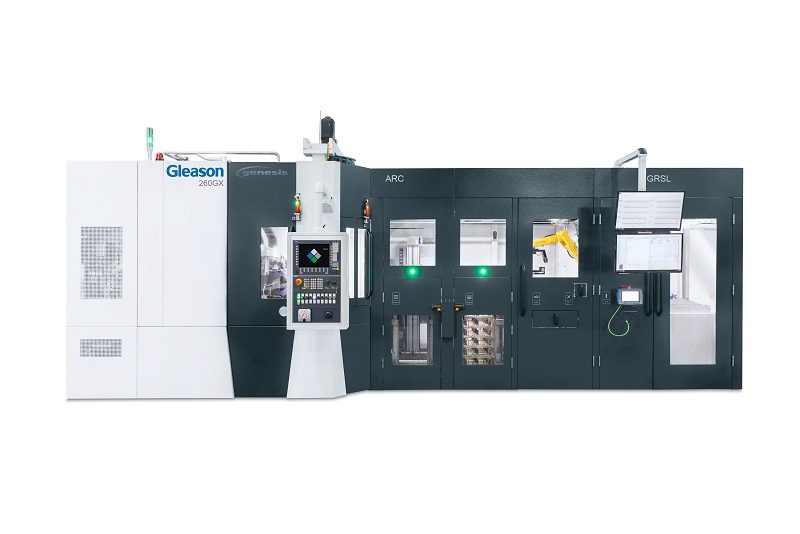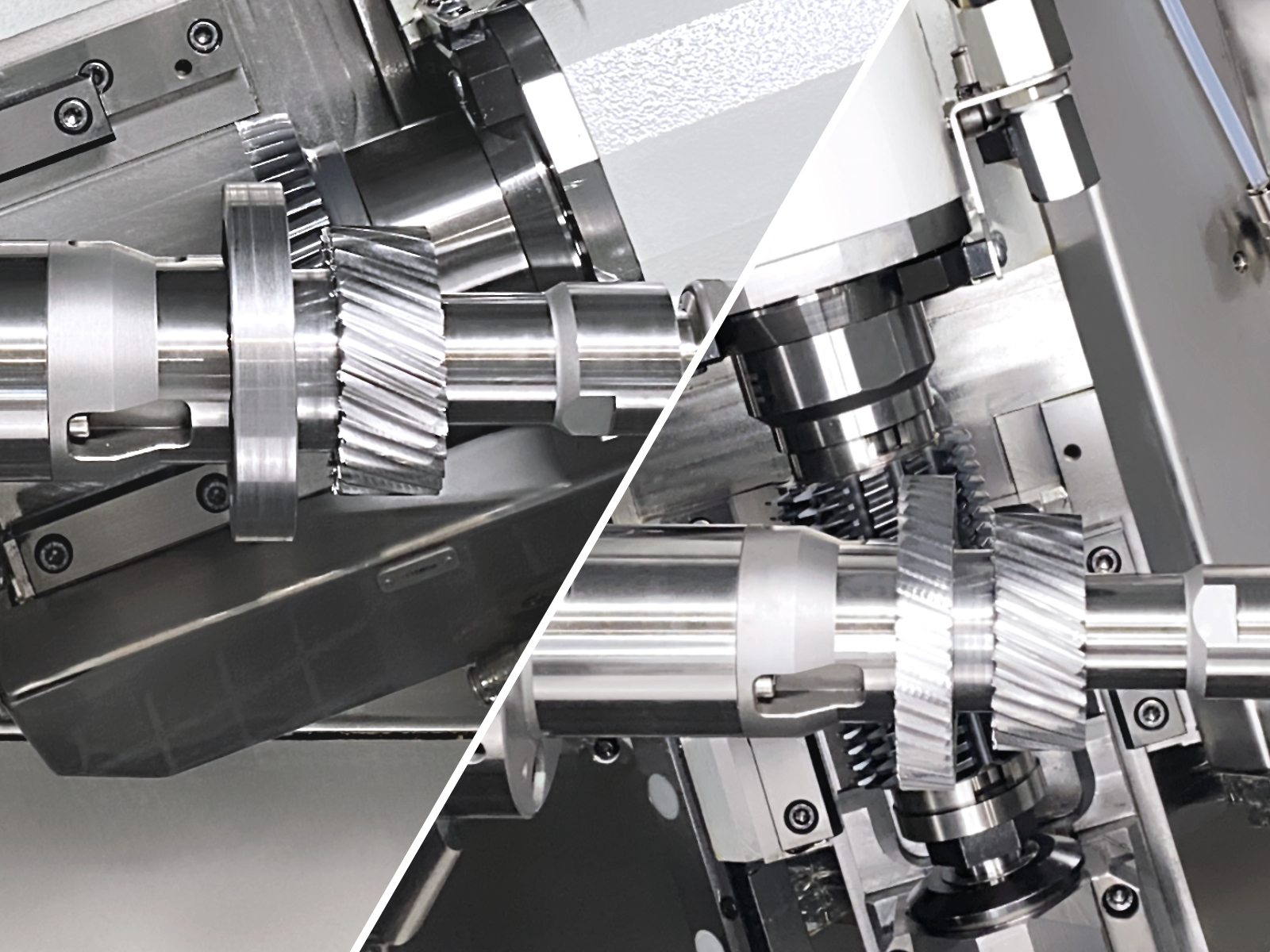
HFC Hard Finishing Cell with in-process gear inspection and integrated gear noise analysis. (Photos courtesy of Gleason)
State of the Gear Industry Perspectives: Gleason Corporation
State of the Gear Industry Perspectives takes an in-depth look at the challenges and opportunities in gear manufacturing today and in the future. Our first installment online is an interview with Udo Stolz, vice president of sales and marketing at Gleason Corporation.
 Udo Stolz
Udo Stolz
What are the greatest challenges to your business in 2023?
Labor shortages, supply chain challenges and the rapid transformation of traditional end-markets including automotive.
What global manufacturing trends are you paying close attention to in the gear industry today?
In the near term, we don´t envision significant major shifts in gear manufacturing technology.
We are focused today on driving the continuous improvement of precision and productivity in existing processes.
These efforts include meeting stringent quality and advanced surface roughness requirements and increased productivity today required by gear manufacturers (particularly EV) in order to minimize noise, vibration and harshness (NVH). Hard fine finishing technologies like grinding and honing and, increasingly, skiving, will play an important role in achieving these goals.
 100PS (Skiving and hobbing in one).
100PS (Skiving and hobbing in one). What is the state of your business regarding training and developing your skilled workforce internally and the state of finding skilled workers to join the organization?
We consider workforce development as a win-win situation. It helps Gleason to continue its many years of industry leadership, while at the same time ensuring career development opportunities, productive new skills and, ultimately, a successful career path for all our employees. The challenge is finding people with the right skills and qualification. Our internal qualification programs, including apprenticeships, training on the job, digital and on-site learning and/or leadership development programs, all contribute to a better and more qualified workforce.
With our 157 years of experience, we also feel the obligation to offer training to our customers, since they are facing the same challenges when it comes to a qualified workforce. Our Gear Trainer concept (started as Home Trainer during the pandemic) is providing a high-level education for thousands of participants every year free of charge. With Gleason`s unique expertise in “design - manufacturing - inspection” we have the bandwidth to provide in-depth know-how during seminars, on-site courses or through the highly regarded Gear School. Our employees greatly benefit as well from these programs.
How is your organization evolving when it comes to emerging technologies such as IIoT, additive manufacturing, electrification, etc.?
Choosing the most efficient manufacturing technology for a specific part, including machine, tooling, and optimum processing will be the key to success in coming years. Gleason design and manufacturing systems will continuously be improved upon. Integrated closed loop systems with direct feedback to design and manufacturing machines is fast becoming the rule, rather than the exception, for safe, highly accurate production.
Most recently, new inspection methods using laser technology are, for the first time, enabling the in-process inspection and advanced analytics for up to 100% quality and noise control in a high volume, high precision gear production system. The Gleason HFC (Hard Finishing Cell) for manufacturing and in process inspection of e-drive gears is the new benchmark in this regard.
Finally, in order to be viable economically, electrification requires sustainable electricity generation. This offers significant opportunities for Gleason, since we are well positioned with a complete system of solutions for the production of high precision gears now in high demand worldwide in wind power installations.
What role is sustainability and green manufacturing playing in your organization in 2023?
Sustainable development, production and operation of Gleason products has become a standard element of the Gleason Strategy. Wherever possible, Gleason avoid and reduce CO2 emissions across the entire value chain. Efforts include using fewer natural resources, reducing waste, recycling and reusing materials, and minimizing emissions in all relevant processes.
Describe the role automation/robotics plays in your business today and how these technologies will evolve in the coming years?
The shortage of skilled workforce in combination with more attractive robotics pricing on one hand, and increased capabilities on the other hand, offer some interesting opportunities. By having our own automation division, Gleason can meet the automation needs of our internal manufacturing and offer integrated automation solutions for gear manufacturing machines as well as general machine tools for non-gear applications.
In the future, the ease of integration, increased capabilities and improved collaboration will certainly increase the trend for agile production and the use of automation to perform even more complex tasks.
As gear shopfloors become more data-driven, how will hiring practices change in the gear industry moving forward? Do you believe it’s necessary to bring in system integrators, data engineers, and mechatronics experts to diversify your workforce?
Data generated by machine and process monitoring can be overwhelming, so transforming ‘big data’ into ‘smart data’ will be a key success factor. That requires the engagement of other qualifications in addition to the ones in use today. The evolution from focusing on mechanical and then to electronics/controls will shift more and more towards data generation and evaluation. This will drive the adaption of the aforementioned qualifications.
How will the gear industry change and evolve in the next five years?
Quality requirements and cost per piece are still going to drive future gear design and manufacturing strategies. The tailored solution which fits best to achieve the task will succeed.
Due to the electrification strategies in automotive, the overall number of gears will be lower, but more sophisticated and complex. Since manufacturing solutions alone will not be able to guarantee success, integrated design, manufacturing and inspection solutions in a Closed Loop system will be important keys for future success. As the design parameters and the cost per piece for specific manufacturing processes are already set during the design phase, it will be mandatory to provide gear and transmission designers with some substantial manufacturing know-how. Gleason has already started to integrate this kind of knowledge into the design software itself. Inspection results and advanced waviness solutions will automatically provide feedback to design and manufacturing experts so they have an immediate understanding of whether specific gear designs can meet the targeted NVH requirements.
At Gleason, we are convinced that for the automotive industry in particular ‘smart’ processing will be a major key to success. Only through Closed Loop “Design-Manufacture-Inspect” solutions in combination with highly accurate, productive and reliable machining systems will our customers be able to achieve their very ambitious production requirements going forward.
